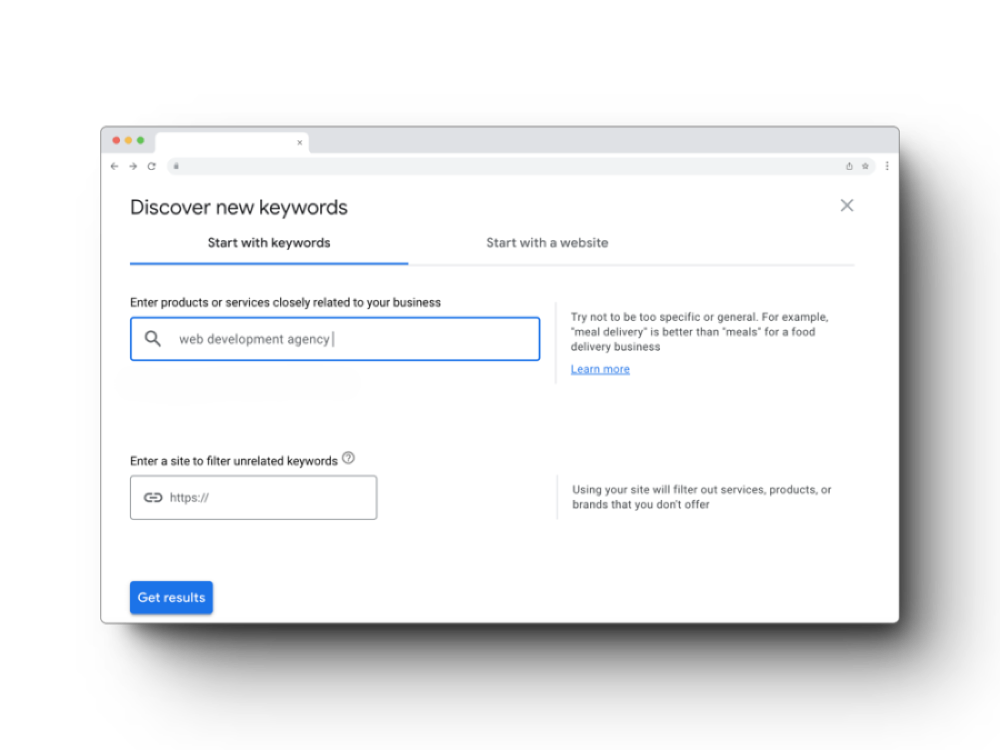Are you searching for the term “how to rank higher on Google”. Perhaps your company has a website, plenty of content, and a a sleek and professional design but it’s search engine ranking is lower than you expect. You’re wondering how can I get this higher?
In this article we’ll explore how the practice of Search Engine Optimisation (SEO) can help you. Before we begin it’s worth pointing out that SEO is a complicated topic and in the space of one article it’s only possible to scratch the surface with what is possible. Regardless of these limitations we hope we can give you a good base knowledge that can start you on the journey to higher rankings for your website.

How to rank higher on Google by SEO optimisation
SMART keyword research
Keyword research entails identifying terms that your customers search for most frequently. Creating a robust list of keywords forms the cornerstone of any SEO strategy. A keyword can be as simple as “Ice cream shop near me” or more complicated like “ice cream flavours that are suitable for celiacs”. At the very start you’ll want to consider as many relevant keywords as possible.
To conduct keyword research, the initial step is selecting a suitable tool based on your business needs. Free tools like AnswerThePublic, Google Trends, or Google Keyword Planner are available. However, investing in tools such as Ahrefs or SEMRush, if within your company’s budget can provide more comprehensive keyword insights, including volume, difficulty (a measure of the competition required to beat in order to rank).

(Google Keyword Planner is an excellent choice for keyword research)
When starting out, it is advisable to prioritize long-tail keywords and avoid the allure of high-traffic short-tail keywords initially. Short-tail keywords typically consist of 1-3 words, covering broad topics and representing general search terms. These keywords are often highly competitive, dominated by established companies with significant SEO investment and dedicated teams. As a result, it can be challenging to achieve quick results. To establish a foothold and maintain motivation, consider starting with less popular long-tail keywords that are more specific, typically consisting of 3-5 words and targeting niche demographics.
Once you have a list of keywords, the next step is categorising them into groups, forming what’s known as a keyword cluster. You’ll develop a pillar page as core content and gradually create related content around that pillar. This approach facilitates keyword management and helps you avoid producing repetitive articles, which could lead to penalties from Google. You can also use the related keywords you find to inform the content of your existing pages and help target the pages around one content pillar or one small group of keywords.
For example on our web design and development agency site we have found that people often search for “web development” and for “website maintenance retainer“. Now these services are very similar, and are delivered by the same people, but if were to try to cover both on the same page then we would probably fail to reach a high ranking position. So instead we have split the topics into two and made an individual page for web development and an individual page for website retainers.
Whether it pays off is still to be decided, there is no specific rule for when or how you should split a topic in two and create two more focussed pages, but in many cases trying to rank for a large number of terms with the one page broad page is unlikely to produce great results. The reason being that someone else has probably already created a page that targets a specific term and is therefore seen in the eyes of Google and the end users as answering the search query in question more effectively.
🌊 You won’t get lost in the data from your website. We’ll explain what your data means and how to use it to get more visitors and sales. Get a quote →
Improve the quality of your site content
When it comes to SEO content, there are three key areas that you should be aware of: search intent, user focus, and originality.
Search intent involves tailoring your content to match the purpose of what people are searching for. There are four types of search intent: navigational, informational, commercial, and transactional. Aligning your content with the search intent enhances the audience’s perception of your content. For example, if someone searches for “best web agency in the UK,” it falls under the commercial category, indicating that the user seeks thorough research before making a decision. Your content should provide company reviews, testimonials, or comparisons to meet this intent.
Another critical factor is originality. With the rise of generative AI tools, low-quality copy and paste AI-generated content has flooded the internet. The latest Google core updates have imposed penalties on websites made up of content like this. The recent updates, emphasise the importance of producing good quality content in order to rank. While using AI isn’t inherently wrong, it cannot produce content as valuable as that created by human creativity and insight.
Lastly, have you heard of E-E-A-T? It stands for Experience, Expertise, Authority, and Trustworthiness. These are concepts used to evaluate the quality of content created by real people who contribute to Google’s search results. Google’s algorithms rank your site based on its relevance and usefulness to users. If your site aligns with Google’s evaluation criteria, it is more likely to be considered helpful and rank higher in search results. For instance, when your site is referenced or mentioned by another trusted site, you’re more likely to rank higher in search results.
Work on the on-page optimisation
On-page optimisation is essential work that should be completed before publishing your article. We recommend creating a checklist to focus on optimising these elements:
- Title Check: Ensure your title includes the primary keyword and is approximately 50-60 characters in length.
- Meta Description: Provide a brief overview of your content to improve the click-through rate (CTR). Keep it under 100 characters for optimal effectiveness.
- URL Slug: Ensure your URL is concise and includes primary keywords. Avoid irrelevant or overly long URLs.
- H1 Tag: Use only one H1 tag for the article and keep it under 60 characters.
- Subheadings: Utilise H2, H3, H4, etc., to structure your content effectively and make it easy for the audience to read. Keep them short and succinct.
- Internal Links: Include relevant internal links to the pages you want to direct audiences to. Use anchor text for description.
- External Links: Use them when citing data, information, etc., from authoritative sites. Ensure the sites are trusted.
- Featured Image: Use relevant and engaging featured images for the post. Ensure the photo is licenced for use on the site.
- Image Alt Tags: Each image should contain a descriptive ALT tag to assist people with visual impairments.
- Image Optimisation: Check that images are optimised for fast loading by compressing and correctly sizing them.
If you have a WordPress website you can consider a popular plugin like YoastSEO or AllInOneSEO to help you manage this data. It’s not 100% required but it can help you to visualise how your search engine listings will look when you add in content to the meta description and title. Each of the providers listed offers a free version of their product which for beginners is more than satisfactory. Yes, you will have to click through some screens encouraging you to sign-up to the Pro version and dismiss the odd notice, but it’s not too intrusive, and despite the small distractions we’d still recommend giving one of them a go.
Run a Technical SEO audit and fix the issues
You can conduct a technical SEO audit using free tools like Google Search Console or paid tools like SEMrush to identify technical SEO issues that need fixing.
Common issues you may encounter include crawling, indexing, rendering, and website architecture. Here are some key points to consider:
Site Architecture:
- Ensure a well-designed site structure for better crawling and indexing. Create a flat and organised layout where pages are easily accessible with minimal links.
- Maintain a consistent URL structure to enhance visitor navigation.For example, Kahunam uses clear URL structures that define the location, content, and category.
- Use breadcrumbs navigation to automatically include internal links to categories and subpages, improving site architecture.
Identifying Crawling, Indexing, and Rendering Issues
- Manually add internal links if Google has difficulty reaching deep content.
- Submit an XML sitemap for indexing.
- Request URL indexing through Google Search Console if your URLs are not indexed.
- Use canonical tags to indicate to search engines the prioritised indexed content in case of accidental duplicate content.
Addressing Page Speed Issues:
- Optimise webpage sizes by balancing image quality and loading speed.
- Test your site’s speed using tools such as webpagetest.org with or without Content Delivery Networks (CDNs).
- Remove unnecessary third-party scripts that can slow down page loading.
Additional Technical SEO Tips:
- Implement hreflang tags for international websites.
- Regularly check for dead links and fix them by updating, removing, or setting up 301 redirects.
- Create a custom 404 error page with helpful navigation links.
- Although creating structured data (schema markup) does not directly impact SEO, it enhances search result snippets and improves click-through rates in organic search results.
Monitor your off-page SEO regularly
Off-page SEO, also known as backlink strategy, plays a significant role, contributing up to 80% towards improving your site’s ranking on Google. It’s a potent tactic that can accelerate your site’s ranking. You can acquire backlinks by reaching out to other site owners and securing agreements to include links to your site, typically within articles containing anchor texts directed to your site.
One of the most important aspects of backlink building is the site authority. You can use free tools like Moz to assess the Page Authority and Domain Authority scores of a site. While some sites offer backlinks, it’s crucial to conduct a thorough review before investing. Regular backlink reviews are essential because Google may identify spammy links from low-quality sites, and in some cases, these links can result from an SEO attack.
There’s a technique to remove detrimental backlinks called “disavow links.” Essentially, you compile a list of links you wish to disavow, then submit it through Google Search Console. This action severs the connection between your site and those links. In essence, our advice is quality over quantity. Rather than inundating your site with numerous low-quality backlinks, prioritise acquiring high-quality ones, as the impact can be exceedingly positive.
Start increasing your site’s rank on Google today
We hope you now have a surface level knowledge of how to rank higher on Google and have a few ideas you can start to apply to your own website today. There’s a lot to do and remember it’s an ongoing job that you’ll need to keep on top of as your website changes and grows. And as your company begins to grow it makes sense to consider adding a specialist to your team or enlisting external help. – a combination of on-page, off-page, technical optimisation, backlinks, and content audits.





